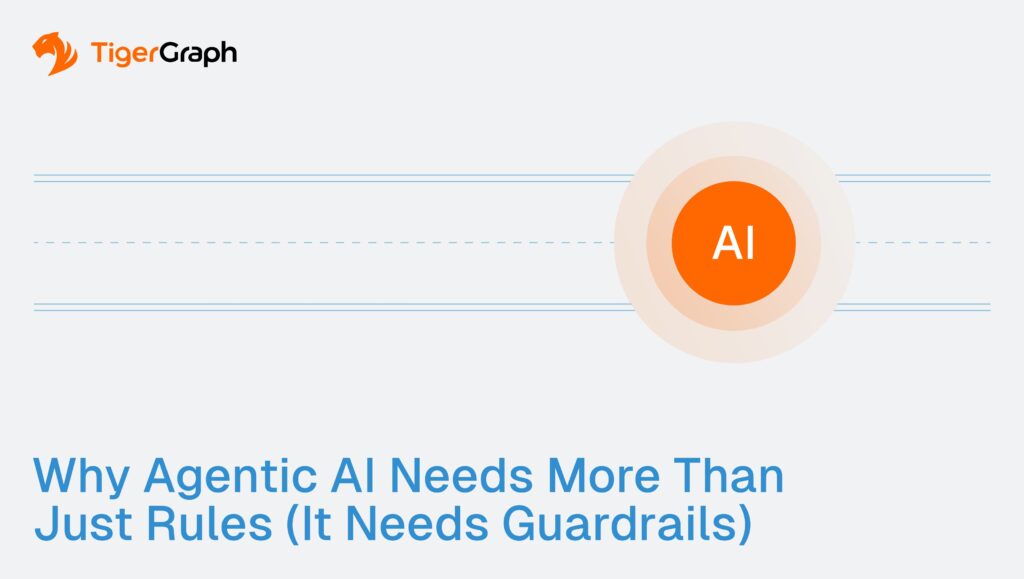Graph Keeps Agentic AI Systems Safe with Guardrails, Not Guesswork
In the world of autonomous AI, control is everything. And agentic systems, consisting of AI agents capable of setting goals, making decisions, and taking action, are quickly moving from experimental to enterprise. But as autonomy grows, so does the need for accountability. And that raises a critical question: what shouldn’t an agent do?
When agents act independently, they need more than instructions—they need boundaries. Business rules, ethical norms, risk thresholds, compliance constraints. These are non-negotiable in enterprise environments. But they can’t be bolted on after the fact, and they can’t be static. Agents operating in dynamic systems require guidance that adapts in real time, and that’s where traditional rule engines and hardcoded logic fall short.
Graph Provides a Better Foundation
Unlike rigid policy frameworks or black-box heuristics, graph technology encodes guardrails as contextual, adaptive relationships. It enables AI agents to reason not just about their goals, but about the environment, policies, and people they’re accountable to, before they act.
And with TigerGraph, that reasoning becomes fast, scalable, and transparent. It’s built directly into the agent’s decision logic from the start.
Why Guardrails Matter More Than Ever
Agentic AI has enormous potential, but that potential comes with risk. When AI agents are capable of acting on their own, even small blind spots can lead to outsized consequences. A customer service agent might escalate too quickly, or not at all. A digital assistant in a regulated industry might pull in outdated policies or make recommendations that don’t meet compliance standards. An engineering co-pilot might initiate actions based on an old version of a system spec.
And these missteps don’t stem from malice or malfunction. They happen because the agent didn’t know better, because it wasn’t grounded in the right context.
Large language models (LLMs) are generative, not judgmental. They can produce convincing outputs, but they lack built-in guardrails. They don’t retain long-term memory, track behavioral norms, or infer relationship dynamics across tasks and tools unless that structure is provided to them. In critical enterprise workflows, that’s not good enough.
You want a model that can produce language, but you need one that understands the environment in which it is operating. An agent that knows the difference between typical and risky, standard and exceptional, appropriate and potentially harmful.
Another concern is that GenAI works on statistical probabilities, not clearcut facts. The statistical nature is what enables it to produce fresh-sounding content, but it also means that once in a while, it will hallucinate and produce something that isn’t true.
That’s where graph comes in.
Graph technology models clear knowledge, principles, and their meaning. With a graph, you can encode business rules, behavior boundaries, relational norms, and access controls directly into the system. These become traversable, queryable structures that guide agents in real time.
Instead of relying on post hoc filtering or static prompt instructions, agents backed by graph can check their context before they act, ensuring decisions reflect your goals, policies, and risks at that moment. It’s the foundation for responsible autonomy.
Graph Is the Foundation for Responsible Autonomy
For agentic AI systems to operate responsibly, they need more than a list of rules. They need a living framework that reflects how your organization works.
Traditional systems often rely on brittle rules engines or hard-coded workflows to enforce business logic. But these approaches lack flexibility, adaptability, and context. They don’t evolve as the environment changes, and they don’t scale well across diverse use cases.
Graph offers a fundamentally different approach.
Instead of embedding rules in procedural code, graph technology allows you to model the logic of your system as part of the data itself. Relationships, policies, constraints, permissions, and behavioral norms all become part of the graph structure. They’re referenced, encoded, and enforced through the graph’s topology and traversal logic.
With TigerGraph, these embedded guardrails are:
- Persistent – They’re not tied to a single session or prompt. The logic lives within the graph and is accessible at any time, across agents, users, and tasks.
- Compositional – Guardrails can be linked to both entities and relationships, meaning your AI can reason not just about who someone is, but what they’re allowed to do, with whom, and under what conditions.
- Context-aware – As data updates in real time, so does the logic. If a user’s role changes, or a project’s risk status shifts, the graph reflects that immediately—no manual rewiring required.
This means when an agent queries TigerGraph, it’s not just pulling isolated facts. It’s operating within a connected, rule-informed environment—one that understands who can do what, when, and why.
That is real-time reasoning, powered by a structure that keeps autonomy aligned with accountability, moving the needle from manipulating data to recognizing constraints.
From Data to Constraints
TigerGraph’s platform is built for complex, real-time, multi-hop reasoning. It’s the exact kind of traversal needed to keep autonomous agents safe and aligned. Here’s how it works in practice:
- Behavioral Boundaries: Encode what “normal” looks like for an agent, user, or process. If an action deviates from expected behavior, the graph flags or blocks it.
- Access Control: Link permissions not just to users, but to roles, contexts, timeframes, and relationships. Agents can check, for example, whether a customer is eligible for a refund based on their purchase history, account status, and prior exceptions, without brittle if-then logic.
- Dependency Awareness: Agents can map dependencies between actions before executing them. If a task requires approvals or data from another workflow, the graph can enforce that sequence.
- Explainable Rejection: When an agent refuses to act, it can explain why, because the graph contains not just the data, but the logic and history behind the decision.
This isn’t about replacing LLMs. It’s about complementing them. Graph gives structure to autonomy.
Real-World Example: Agentic AI in Customer Service
Imagine an agentic AI system supporting a telecom provider. The system fields upgrade requests, troubleshoots issues, and offers new promotions.
A customer calls to request a plan downgrade. The LLM knows how to respond, but the graph determines what it’s allowed to offer based on:
- The customer’s tenure, usage, and history of plan changes
- Internal policies about downgrade limits
- The retention team’s intervention rules
The agent doesn’t guess. It checks. The result? A decision that’s fast, fair, and explainable.
From Black Box to Guardrails You Can Trust
Agentic AI isn’t just about autonomy—it’s about alignment. And that means building systems that not only generate actions but understand when not to act. Graph technology enables this by embedding policies, relationships, and constraints directly into the environment in which the agent operates, not as a layer added on top, but as part of the decision-making fabric itself.
TigerGraph makes this real, operational, and enterprise-ready. With real-time graph traversal, built-in algorithmic logic, and distributed performance, TigerGraph empowers agents to reason across context, roles, and history before executing a decision. It results in systems that adapt dynamically, explain themselves clearly, and stay aligned with your organizational values.
In a world where AI will increasingly act on our behalf, graph provides the connective structure that keeps agents grounded. And TigerGraph turns that structure into a scalable, intelligent foundation for responsible autonomy.
Try TigerGraph Savanna free today—the fastest way to build, scale, and run graph-powered AI applications in the cloud. https://tgcloud.io

